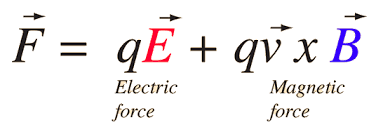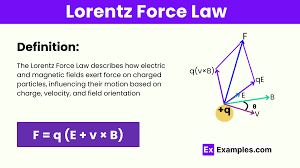Lorentz Law Explained: Definition, Formula, Diagram & 5 Real-Life Applications
📖 Definition of Lorentz Law
Lorentz Law states that a charged particle moving in a magnetic field experiences a force perpendicular to both the velocity of the particle and the magnetic field direction. This force is called the Lorentz Force
🧮 Lorentz Force Formula

Where:
– F = Lorentz force
– q = charge on the particle
– E = electric field vector
– v = velocity of the particle
– B = magnetic field vector
– × = vector (cross) product
Explanation in Simple Terms
When a charged particle like an electron moves through a magnetic field, it gets pushed sideways. This sideways force causes the particle to curve or spiral, depending on its velocity and the field direction.
Lorentz Law Diagram Description

Imagine this:
– A positive charge moving to the right
– Magnetic field directed into the screen (represented with ‘×’)
– The Lorentz Force points upward (using Fleming’s left-hand rule)
The force is always at right angles to both the magnetic field and motion.
5 Real-Life Applications of Lorentz Law
- Cyclotrons and particle accelerators – Control paths of protons/electrons
- Mass spectrometers – Identify elements by deflecting ions
- Magnetron (microwave oven) – Uses Lorentz force to spin electrons
- Auroras – Earth’s magnetic field deflects solar particles
- Electric motors – Rely on magnetic forces on current-carrying conductors
Quick Facts
– Lorentz Force affects only moving charges
– The stronger the field or velocity, the greater the force
– If motion is parallel to field, no magnetic force acts
FAQs
- Who discovered Lorentz Force?
👉 Hendrik Lorentz, a Dutch physicist in the late 1800s.
- What is the difference between Lorentz Force and Magnetic Force?
👉 Lorentz Force includes both electric and magnetic components.
- Where do we see Lorentz Law in daily life?
👉 In electric fans, MRI machines, and even in space phenomena like auroras.